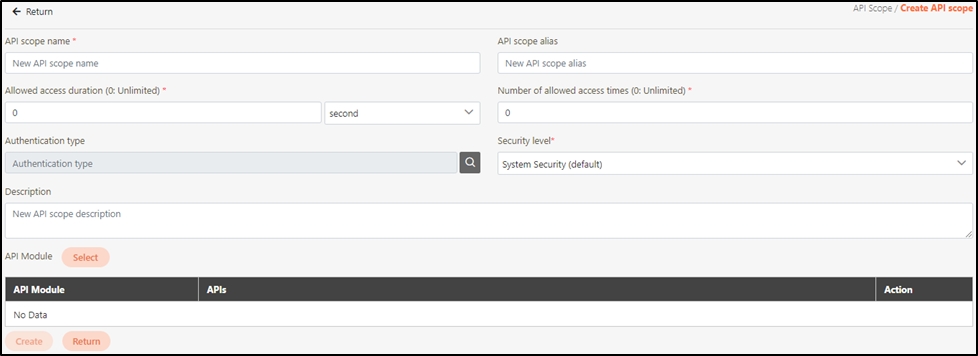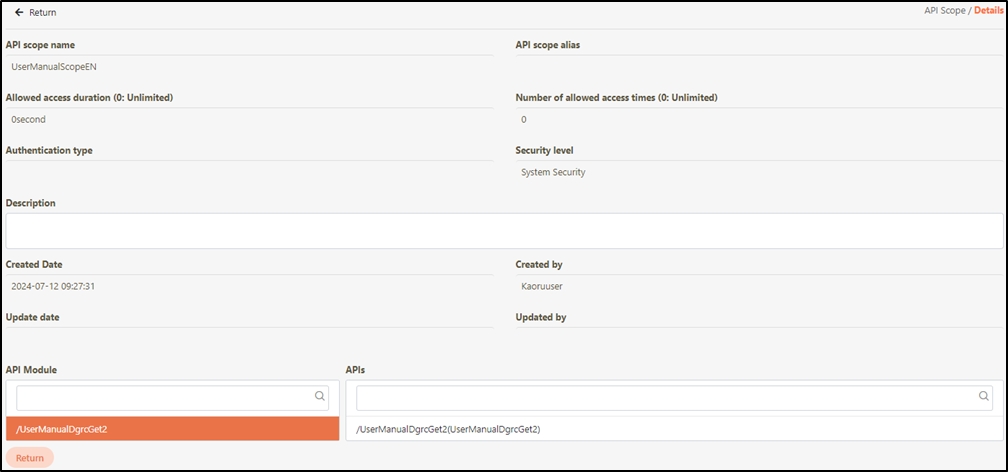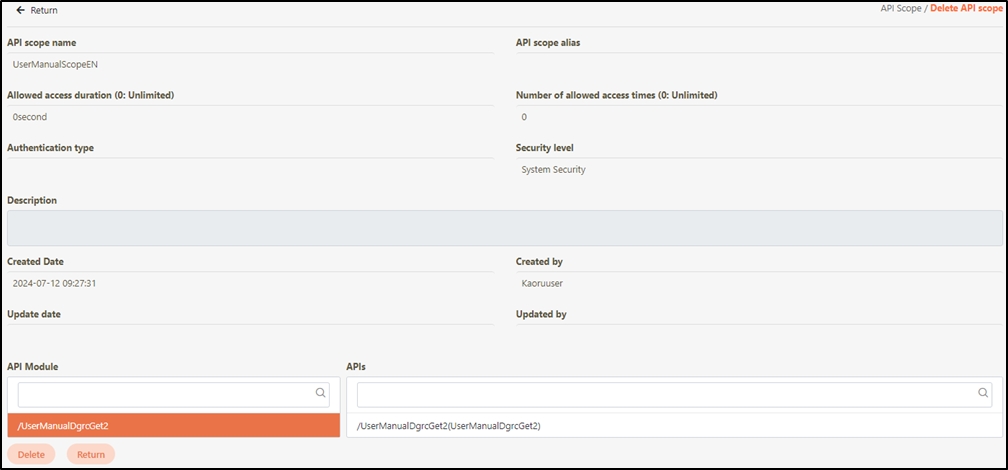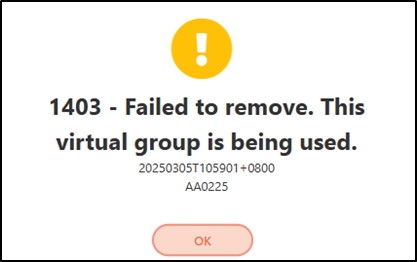API Scope
Path: Client Management > API Scope
The API Scope function is for outsourced vendors to use to apply for API functions from our bank in place of users. For example, when a user wants to query his/her demand deposit balance at TPIsoftware Bank through the authentication network, the authentication network will redirect the user to the application authorization page of TPIsoftware Bank, where TPIsoftware Bank will verify the personal information of the user, then ask the user to select the information he/she wishes to view, and authorize it.
API Scope Management is for creating and maintaining APIs that can be selected and authorized for end users.
APIs with the same authentication type can be placed under the same scope here, and the APIs in this scope will correspond to authorizable client permissions according to the security level set.

Create API Scope
In this section, you can find instructions on how to create API scopes.
Click Create API scope to access the creation page.

Fill in the data or make selections as instructed below. The fields marked with “*” are required.
API scope name*: Name of the scope. Cannot be changed once created.
API scope alias: Alias to help identify the scope.
Allowed access duration (0: Unlimited)*: The duration valid for this group; it will become invalid once the time expires. Set to 0 for unlimited duration.
Number of allowed access times (0: Unlimited)*: The maximum number of times this scope of APIs can be authorized; it can no longer be used after the number of times has exceeded. Set to 0 for unlimited duration.
Authentication type: Authentication type required for the APIs in this scope; multiple choices allowed.
Security level*: Security levels A~F; the security level must correspond to the security level of the client’s account.
Simply select the default system security for the security level.
If C is selected as the security level for the client, security levels A and B cannot be found here at API Group.
Description: Description or remarks of the scope.
API Module: Enter to select the API module currently mounted on the digiRunner platform.

Further instructions for completing the fields.
Authentication type: Click on the
 icon to access and select from the authentication list; multiple choices allowed as mentioned above.
icon to access and select from the authentication list; multiple choices allowed as mentioned above.

API Module: Click Select module to enter and select the API module currently mounted on the digiRunner platform.
Access the selection page and search for the module to add with the search field, then click Select at the left to add it into the module list. To cancel, click Delete at the right of the selected module.

At this time, module is added but not API. It is only added to the scope name, but there is nothing inside. Click Select API to complete adding API to the module.

After selecting the API to add, click Apply.

If the scope is created with no API added to the module, this module will not be added to the scope.
Click Create to save and exit.
Search API Scope
Enter the keywords, the authentication type or security level to search for the desired API scopes.

View API Scope
Search for the API scope to view details, and click on the![]() icon to access the API scope details page.
icon to access the API scope details page.
The information in Details is view-only.


Update API Scope
Search for the API scope to modify, and click on the
 icon to access the update page.
icon to access the update page.

Modify the desired fields, and click Update to save and exit.

Delete API Scope
Search for the API scope to delete, and click on the
 icon to proceed.
icon to proceed.

Click Delete to delete the API scope and exit.
Delete the API scope in the Delete API scope page, the warning prompt for deletion will NOT appear.

If this scope is set as available for clients under API Client > Security > API Scope, the error “1403 - Failed to remove. This virtual group is being used.” will appear, meaning that this API scope is in use and cannot be deleted.

Differences Between API Group and API Scope
If Bank A has two apps—one is Bank A's own app, "Bank A App," and the other is an outsourced app, "Online Bank":
When a user applies for account A, the user will be authorized to view the account balance through the "Bank A App."
However, when applying for the outsourced app "Online Bank," the user must authorize and agree for the agent to check the account balance with Bank A. The role of the API Group is similar to "Bank A App," while the role of API Scope is akin to "Online Bank."
Last updated
Was this helpful?
